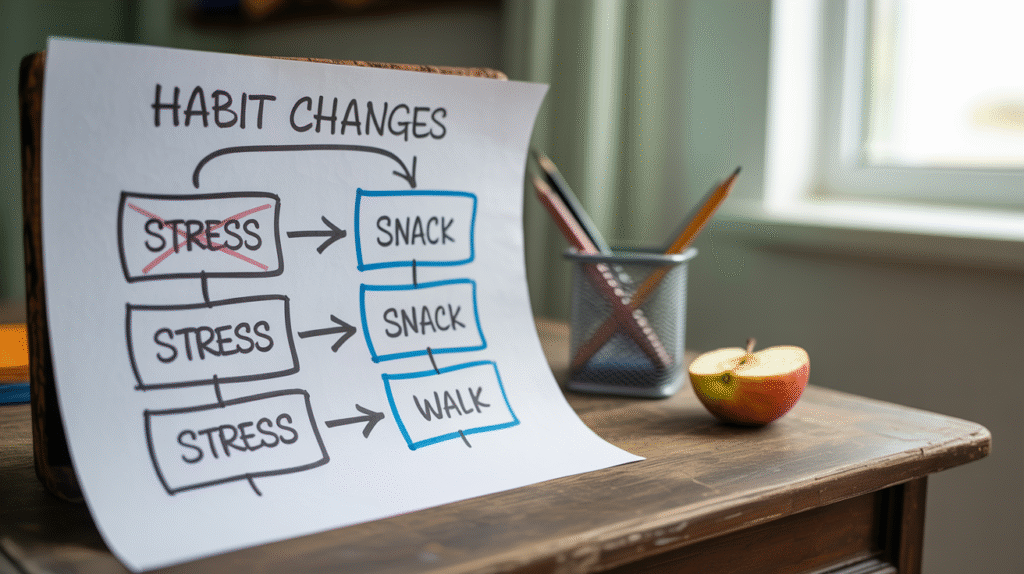
Breaking bad habits often feels like an endless battle with willpower — but what if the real key isn’t fighting harder, but replacing smarter?
Instead of trying to eliminate a habit by sheer force, a far more effective strategy is to substitute it with a behavior that satisfies the same emotional need. This subtle shift in approach can make a massive difference in whether change sticks or slips away.
In this guide, you’ll learn why bad habits are tough to break, how replacement strategies work, and practical steps to swap out old behaviors for ones that actually support your goals.
Bad habits aren’t just random behaviors — they’re shortcuts your brain uses to seek quick rewards. Whether it’s grabbing your phone the second you feel bored or reaching for junk food when stressed, each habit provides a fast emotional payoff.
The tricky part is that your brain focuses more on the reward than the behavior itself. It’s not the social media scroll that’s addictive — it’s the feeling of distraction, connection, or escape that it provides. Similarly, it’s not the candy bar itself, but the quick burst of pleasure or comfort it delivers.
Because bad habits are tied to emotional needs, simply deciding to stop often backfires. Without an alternative way to meet the same need, your brain resists — pulling you back to the familiar behavior that once solved the problem, even if only temporarily.
Understanding this connection is the first step toward real, sustainable change.

Trying to simply erase a bad habit leaves a gap — and gaps create discomfort. That’s why replacement is such a powerful strategy: instead of fighting against an emotional need, you offer your brain a new way to satisfy it.
For example:
By giving your brain something else to look forward to, you maintain the essential reward (relief, relaxation, pleasure) — but redirect the behavior into something healthier.
In short: don’t just remove the habit — replace it with a new path toward the same feeling.
Choosing an effective replacement habit isn’t random — it requires matching the emotional need behind the bad habit. Here’s how to do it:
Ask yourself: What am I actually seeking when I perform this habit?
Understanding the core need helps you select a better substitute.
Pick a replacement that fits the same energy as the original habit.
The replacement should be simple enough that you can do it immediately. If it’s too complicated or out of reach, you’ll revert to the old behavior.
Choose something that genuinely feels rewarding, not like a punishment. The goal is to create positive emotional feedback — not frustration.
By carefully selecting a replacement that fits both the need and the moment, you dramatically boost your chances of long-term success.

Creating a lasting habit replacement isn’t about luck — it’s about strategic design. Here’s how to build a plan that actually works:
| Step | Action | Example |
|---|---|---|
| 1 | Identify the Trigger | Feeling anxious at work |
| 2 | Choose a Quick Replacement | Deep breathing for 60 seconds |
| 3 | Set a Visual Reminder | Sticky note on your desk |
| 4 | Reward the New Behavior | Mentally congratulate yourself |
Instead of leaving it to chance, you create a playbook for your brain to follow. Over time, repetition strengthens the new connection — until reaching for the deep breath feels just as automatic as reaching for your phone once did.
The more you plan for success, the less effort you’ll need to maintain it.
Breaking bad habits isn’t about being stronger or more disciplined — it’s about being smarter in how you design your environment and behaviors.
By focusing on replacing, not just removing, you work with your brain’s natural reward system instead of fighting against it. Every time you successfully substitute an old behavior with a positive one, you reinforce a new pathway that makes change easier over time.
Start small: pick just one habit you want to change, find a meaningful replacement, and set yourself up with a simple plan. Over time, these small swaps add up to big transformations.